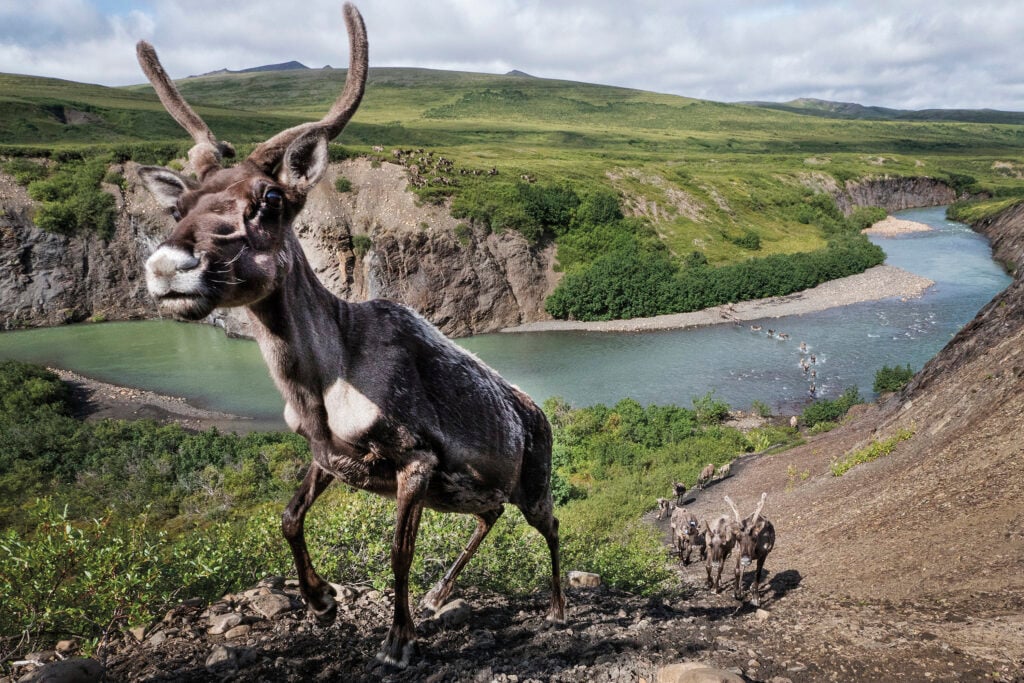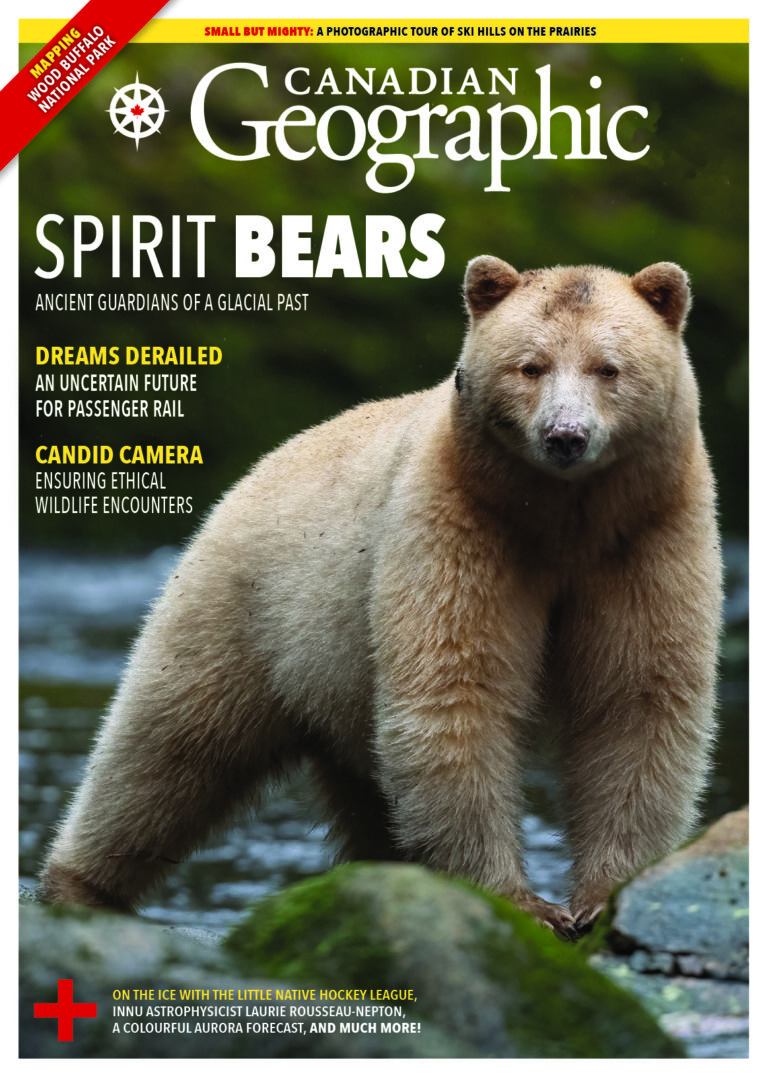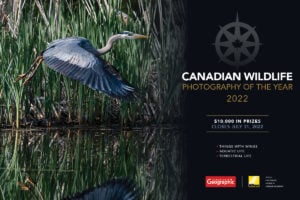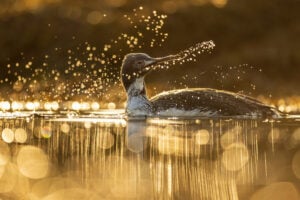
Wildlife
Announcing the winners of the 2022 Canadian Wildlife Photography of the Year competition
Canadian Geographic is pleased to honour 14 photographers for their outstanding images of Canadian wildlife
- 1238 words
- 5 minutes
Wildlife
Wildlife photographers on the thrill of the chase — and the importance of setting ethical guidelines
When John E. Marriott heard a cougar had been spotted in a meadow near the Trans-Canada Highway in Banff National Park, his heart leapt at the chance to see it for himself. Marriott was in his early 20s, working for Parks Canada and dabbling with photography as a hobby. He quickly headed out to the meadow with his brand-new telephoto lens. He found the animal at an elk kill and, thrilled, began snapping photos.
Motorists driving the highway could see Marriott, and they began pulling over to try to spot what he was photographing. The next thing he knew, a park-warden friend was on the scene. “What the fuck are you doing, John?” he scolded.
Now, 30 years on, Marriott says he made nearly every mistake in the book that day. He didn’t bring bear spray, he approached too closely, and he caused a traffic jam. He didn’t notice it then, but the cougar wasn’t happy about his presence — when he looks back at the photos, he can see it was stressed, with its ears pinned back.
“I was just so completely clueless, and that happens a lot with wildlife photographers when they start out,” Marriott says. “It was a total eye-opener… . It’s had a huge impact on shaping my career and on how I approach wildlife photography.”
Since then, Marriott has had ethics top of mind — in his own photography but also in his attempts to educate others through his blog, photography tours and position on the ethics board of the International League of Conservation Photographers.
“The journey with ethics has actually been a lifelong thing—it’s spanned my entire career,” he says. “You make mistakes, and you learn from them. The key is just to not repeat them.”
There’s no singular definition for what constitutes ethical wildlife photography, but it generally means having as minimal an impact as possible on an animal. Baiting wildlife with food to bring them closer, as well as intentionally causing disturbance or distress, is seriously frowned upon.
The goal is to act like a fly on the wall while the animal exhibits its natural behaviours: eating, hunting, sleeping. Detailed, thoughtful guidelines for ethical wildlife photography are readily available, and yet photographer faux-pas remain widespread. Last June, for example, a post on the Ontario Parks blog stated that some photographers had smeared peanut butter and cat food on trees to attract pine marten and cut branches off pine trees to get a better shot.
As more and more people take up wildlife photography as a hobby or career, ethics and education become ever more important. Especially as social media enables spectacular images to be circulated more widely than ever before.
“If one photographer uses bird calls to call in a bird and then leaves, the impact’s relatively low,” says Jennifer Leigh Warner, a Texas-based photographer who is chair of the North American Nature Photography Association’s ethics committee. “But when you’ve got dozens of people [making bird calls], and then they’re posting about it online, and other people want to see that same bird they’re using bird calls, it can be a much greater impact. The popularity of nature photography has grown so much. The more people doing it, the more impact we’re going to have.”
Photographers are often in the field alone, so deciding what’s okay and what’s not frequently comes down to personal integrity. When Brittany Crossman, a photographer based in Riverview, N.B., sees a moose on a highway median, with drivers pulling over to take photos, she refuses to stop and add to the chaos. “Once [the moose] gets overwhelmed, it’s just going to take a split second for it to bolt and run, and if it runs out into traffic along the highway, then that’s not going to be a good situation,” she says.
Crossman often photographs urban wildlife, which she says are typically more used to humans. But if she gets any indication that an animal — for instance, she shoots foxes often — is uncomfortable with her presence, she leaves the area. “Sometimes the animals just don’t want you to take their photo, and you need to respect that and move on.”
When Marriott was working on his photography book The Kootenay Wolves back in the mid-2010s, he made a pact with himself: if a wolf spotted him at a rendezvous site, where they raise their pups, he would never return. About a year into the project, one noticed him and sounded the alarm among the pack.
“That was the last time I ever went in there,” Marriott says. “You’re the one policing yourself in the end. It’s so easy as a wildlife photographer to get caught up in what everybody else is doing: ‘Well, everybody else was out of their vehicle and chasing the bear into the bush. So I just kind of followed along.’ Try not to get caught up in that and stick to your own guns.”
Ethical behaviour can often vary, too, from species to species or from one population to another.
Yukon photographer Peter Mather knows this first-hand. He spent years photographing grizzly bears in the winter. At Łu Ghą, a Champagne and Aishihik First Nations fishing village son the Klukshu River where many homes have sensor lights, he tried using flash on his camera traps — something he acknowledges you have to be very careful about doing in case it disturbs the surrounding wildlife. The bears were unbothered. When Mather tried using flash in a different location — on the Kluane River, where the bears are much less accustomed to both humans and artificial light — they smashed his camera. “I felt pretty bad about that,” he says. “There are so many of these tricky little ethical questions you come across.”
The ethical dilemmas don’t end once the photos are taken, either. Photographers must also think about the impact of how they’re sharing their photos online.
Jesse and Susan Villemaire own Follow Me North Photography, and they often shoot in Algonquin Provincial Park. They never share the exact locations of animals they photograph, even going so far as disabling geotagging in their camera settings. “I think the smallest thing that you could do to help the wildlife is protecting their safe space,” Susan says.
Truth in captioning is another fundamental of ethical wildlife photography. That means being honest about how you got your photo and providing relevant contextual information. For instance, when Calgary-based photographer Jenny Wong shoots a polar bear as people try to move it away from a hunting camp — by shouting, turning on a snowmobile or firing a gun or bear banger — she’ll post a caption explaining why the bear looks distressed. “When an animal is agitated and you’ve taken an image of it, I think it’s pretty important to be transparent about why it’s agitated,” says Wong, who works with a number of outfitters in the North.
On social media, Crossman often sees photos that she knows were taken at a Quebec wildlife park, “but in their captions on Instagram, some photographers try to act like they were out in the wilderness in Yukon and they came across this wolf,” she says. “And it’s just, like, I’ve seen that animal millions of times.”
There are certain red flags that ethical photographers notice immediately — and that the general public can learn to spot too.
Always look at an animal’s body language. Does it look stressed, or is it licking its lips or pinning its ears back? That’s a sign the photographer may have been too close.
How is it behaving? Is it grazing, hunting or sleeping? These are signals that it’s relaxed and comfortable. If it’s running away, it may be trying to ditch the photographer. Wong puts it simply: “Unethical behaviour often leads to butt shots.”
Certain angles immediately lead to questions. A shot of an owl flying right at the camera, with its talons out? Often baited. A kingfisher breaking the surface of the water to catch a fish? Again, often baited — a photographer puts a fish into a glass tank and puts the tank into a body of water.
“It’s quite disheartening to a photographer like me — I took 30 years to finally get a wolverine picture,” says Marriott. “And I can barely even sell it because all these other images are out there.” He’s referencing the multitude of wolverine shots captured in Finland, where the animals are more commonly baited.
Wong would like the viewing public to look at wildlife photography on social media with a more critical eye. “You should think before you double tap,” she says, likening the “likes” to reinforcing bad behaviour. “It’s setting unrealistic standards and expectations for photographers … and encouraging people to either continue doing it or learn how to do it.”
Another red flag can be when a photographer is overly heroic in their storytelling or their tales often involve scary encounters. “I hear so many stories from other wildlife photographers — ‘I got charged by this bear, or had this thing happen to me,’” Marriott says. “In a 30-plus-year career as a wildlife photographer, I’ve never been charged by a bear…. It’s because I’m being respectful generally and not doing things that cause them to want to give me a bluff charge and try to get me to back away.”
Newer technologies, like drones and camera traps, aren’t inherently unethical, but it depends on what species are being photographed and on how the traps are used. While these tools allow a photographer to be much farther away, they can also be a significant disturbance to wildlife.
Mather frequently uses both, and he’s intentional about when and how he uses them. If he puts a drone into the air and can tell right away that an animal is uncomfortable, he takes it down.
In the field, sometimes ethical photographers come face to face with problematic behaviour, whether it’s a misbehaving fellow photographer or an uneducated tourist. Several interviewed for this story said when this happens, they try to educate — for instance, about how feeding wildlife is dangerous because it habituates animals to humans and often results in the animal’s death.
Sometimes, the interaction goes well and the photographer or hiker steps back, saying they didn’t know. Other times, the person gets defensive or angry.
“There’s only so much conversation we can have with people before it becomes a confrontation,” Jesse says. “You can’t police the internet, and you can’t police the world out there. You can be an ambassador for good ethics, and that’s the best that we can be.”
Abdulla Moussa was hiking in Banff National Park in the fall of 2018 when he came upon a large grizzly feasting on grain that had spilled from a train. Moussa had his 500-millimetre telephoto lens with him and began photographing the scene from a distance. When the bear left the area, Moussa cleaned up what he could of the leftovers, reported the spill to Parks Canada and also contacted CP Rail.
Spills have been an ongoing problem in the park, drawing bears to the train tracks where several have been hit and killed over the years. In a bid to raise awareness about the issue, Moussa posted one of his photos on Instagram in 2022, along with a caption calling it “a very dangerous situation for bears and other wildlife.”
Moussa, who is based in Canmore, Alta., got into wildlife photography because it was a way to spend time in nature — he’d bring his camera along on hikes. Taking photos paired well with his passion for conservation. He saw it as a way he could spread awareness about the challenges local species were facing. It’s one of the reasons he co-founded the Canadian Conservation Photographers Collective.
“I think when people see the images, and they see what exists around them, they’re more likely to care about it,” he says. “And they’re more likely to protect it because they realize what there is to lose.”
When photographers have this conservation mindset — with a desire to act in animals’ best interest — behaving ethically only makes sense. But even for those more interested in Instagram fame, there’s an argument to be made that ethical photography actually results in better photos.
“When you’re putting undue pressure on an animal, it never feels like that moment, that encounter, that you want to talk about for the rest of your life,” Wong says. “It’s not special. It might result in a special image, but there’s nothing special about a bird flying into a tank or an owl that you baited, instead of an owl that you waited years for to look down the barrel of your camera.”
The good news is that it’s easy to find information on how to do things right. A number of the photographers interviewed for this story offer courses and workshops on shooting wildlife more ethically. Many organizations have also produced comprehensive sets of guidelines.
The North American Nature Photography Association’s field practices recommend being mindful of ecosystems’ fragility and staying on trails, learning patterns of animal behaviour and being a good role model to other photographers. The organization is working on a comprehensive e-book that will cover “everything from how to handle specific types of animals to entering private land to the captioning,” says ethics committee chair Jennifer Leigh Warner. Because of new technology like drones and artificial intelligence, the book draft has had to be revised several times. “It’s a very big team effort putting lots of forethought into basically any ethical situation a photographer might run into,” she says.
The Canadian Conservation Photographers Collective also has a code of ethics for its members. In the field, photographers are to be careful of using flash at night, should not use call recordings to attract animals and should be mindful of disclosing the location of animals, particularly those that are rare or breeding, among other recommendations. When disseminating photos, the code also stresses being truthful in your captions — for instance, disclosing whether an animal is in captivity — and never using digital manipulation to purposely deceive.
“Ethics are really central to what we’re doing,” says Josh DeLeenheer, who co-founded the collective with Abdulla Moussa and others in October 2021 to unite photographers who promote conservation through their work. “We don’t want to be responsible for damaging or threatening wildlife, or even doing anything that would cause harm, while we’re trying to create this message,” he says. “We feel it’s important to hold ourselves accountable.”
The National Audubon Society focuses on the huge genre of bird photography and videography. Its guidelines include removing GPS data from images of rare or sensitive species like owls, not using drones (especially at nests) and using a telephoto lens to keep your distance.
All of the photographers interviewed for this story said something similar: they’ve made mistakes, they’re not perfect, they’re always learning. No one was self-righteous.
“I think a part of being an ethical wildlife photographer is also questioning your own ethics each and every time you go out in the field,” Jesse says. “There’s going to be moments where you’re going to leave the situation and wonder: did I put any unnecessary stress on that animal? Or did I spend too long with that animal in the field? Did I disrupt their behaviour?”
In the winter of 2022, Jesse and Susan’s care and consideration paid off when they had what she calls their “National Geographic moment.” They drove for hours into northern Ontario, looking for snowshoe hare tracks to alert them to the presence of what they were really after: the elusive Canada lynx.
They discovered a family of four yearling lynx kits hunting with their mother, so they strapped on their snowshoes and waded into the waist-deep snow. Using their long lenses and making sure to keep a respectful distance, Jesse and Susan watched the lynx as the lynx watched them. Then the animals began hunting, wandering through brush and fields. They followed and watched in amazement as one of the siblings returned with a snowshoe hare dangling from its mouth.
“It’s those quiet moments with just yourself and the wildlife and just appreciating them and not overstaying your welcome,” Susan says of why she loves this field of photography. “We’re so grateful to have that moment, and if we never have it again, it’s still etched in the brain…. I think you have to find a joy in the doing, in the going out. And that has to be part of it for you, I think, is that time in nature — regardless of if you see the wildlife or not.”
When the Villemaires posted their images online, multiple photographers reached out, offering them money to disclose the animals’ location. Jesse and Susan, of course, refused.


















This story is from the January/February 2024 Issue

Wildlife
Canadian Geographic is pleased to honour 14 photographers for their outstanding images of Canadian wildlife

Wildlife
An estimated annual $175-billion business, the illegal trade in wildlife is the world’s fourth-largest criminal enterprise. It stands to radically alter the animal kingdom.

People & Culture
Submit your best wildlife photos for a chance to win cash prizes and see your work published in Canadian Geographic

Wildlife
Canadian Geographic is pleased to honour 15 photographers for their outstanding images of Canadian wildlife